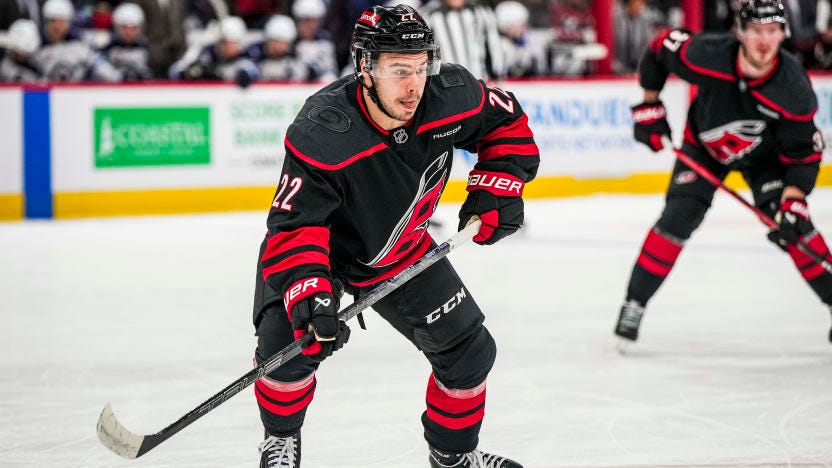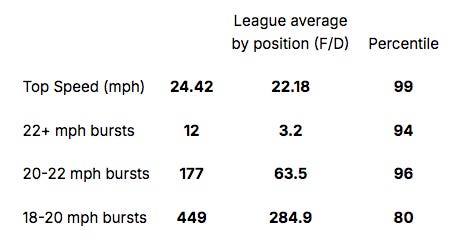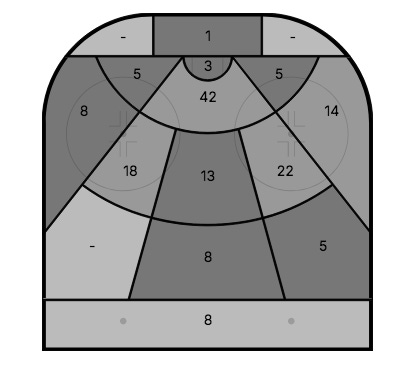
Let’s hit pause on the Mikko Rantanen discourse for a bit and explore the other side of the equation. While the Hurricanes (2nd in the Metropolitan Division) would have loved to sign the big Finn to an eight-year contract, the package they received in return is nothing to scoff at.
Its centerpiece, Logan Stankoven (31 points in 63 games), is a burgeoning top-six forward who matches the team’s identity to a tee. Moreover, the 22-year-old represents both a long-term building block and an instant-impact spark plug.
Here’s how he can strengthen Carolina’s ranks this spring and beyond.
Puck Pursuit
The Canes’ recent roller-coaster ride has brought tactics into sharp relief. If you’re going to succeed in Rod Brind’Amour’s uptempo, forecheck-heavy system, you need…well, a taste for tempo and forechecking. I guess that’s obvious.
As GM Eric Tulsky told reporters, Stankoven’s new fit is also obvious:
“When he's going and recovering loose pucks, he's always the first one in on it, he's always there pressuring and getting into people's bodies and making things difficult. He's not the tallest guy in the world, but he plays bigger than he looks and he plays hard and he competes hard and that's what we look for in a Hurricanes player. ... A player who is going to be a long-term fit for us."
In truth, he almost played too fast in Dallas and might have benefited from exhaling every now and then. Surrounded by fellow all-gas, no-brakes forwards in Carolina, the 47th overall pick in 2021 may have joined the right environment for his frenetic tendencies to flourish. Flooring it in puck pursuit feels like the squad’s #1 priority—and that comes naturally to the rookie:
Before diving any deeper, it’s worth noting that he’s more Tasmanian devil than cheetah, which should put any notion that the Canes have acquired another Seth Jarvis to bed.
They’re not the same:


Look at the bottom row of their skating metrics. Despite Jarvis’ ridiculous edge in top speed, Stankoven consistently plays closer to his ceiling. His motor is undeniable and enables the diminutive forward (5’8”, 165 lbs) to torment defensemen on retrievals.
That seemed evident on paper yet didn’t leap off the screen until he traded a half-engaged linemate (Andrei Svechnikov, day-to-day with an upper-body injury) for two fully committed ones (Jordan Martinook and Jordan Staal).
Since the swap, we’ve seen Stankoven flex his hustle, fearlessness and nose for the puck on a nightly basis. He’s looked the part of a chip-and-chase monster, zooming past the obstructing D-man to contest possession down low. He may be the league’s single smallest F1, but he does the job quite well. Consider these clips from his two latest outings:
The structure of Carolina’s forecheck is so dependable that he isn’t asked to track down and dispossess opponents himself. Anything less than a clean first pass will funnel the action straight into Staal or Martinook’s waiting arms. Fortunately, Stankoven does possess that gift for first-wave disruption. Smart angles, a firm handle on when to go stick/body first and a healthy dose of jam.
As the F2, Stankoven offers Brind’Amour clever supporting routes as well as a trait that few of his hounds display: puck poise.
He arrives on time to tip the scales in the Canes’ favor, then shows the patience to connect the dots under pressure. From off to on puck, there’s a jarring speed change that appears to freeze defenders:
Recognizing that Sean Couturier (PHI 14) is about to win the leverage battle, Stankoven switches from deep outlet to supporting actor, outnumbering Philly’s captain to secure the puck. From there, he hangs on for an extra beat that feels like an eternity. Three Flyers are anticipating a sudden movement, but he’s just waiting for the two nearest defenders (PHI 14 and 36) to peel off the wall in order to link up with Martinook (CAR 48).
Slip pass to Staal (CAR 11) —> shot attempt from the circle.
Although Stankoven isn’t the Canes’ lone puck retriever, his decision-making upon retrieval is uncommon on this roster. He provides an element of interplay and an attacking mentality to the club’s cycle game. They’re not settling for possession and a reset. They want to score in a hurry.
Here’s another example:
As Yanni Gourde (TB 37) bears down on him upon recovery, the Canes-y choice would be a chip-in. Instead, Stankoven opts for a patient two-man game with both of his linemates:
Tucks the puck to Staal between Gourde’s feet and opens his stance to invite a dish once the Lightning forward glides past him.
This compels Oliver Bjorkstrand (TB 22) to apply pressure on the center.
A return feed allows Stankoven to skitter downhill into the space that’s been vacated by the high defenders.
Passes to Martinook, charges toward the far post and Carolina’s rapid-fire design comes within a hair of materializing.
All that due to Stankoven’s knack for slow-playing his touches along the boards.
In fairness, the freshman has his blemishes. Even he would own the drawbacks of his slight frame in 1-on-1 duels (e.g. puck protection). In addition, he’s been late to pick up Carolina’s NZ pressure as the F3 on a couple of occasions, resulting in near-misses on the rush:
Without the straight-line wheels or wingspan to play catch-up in transition, he must learn to balance depth and puck scanning if he wishes to play center in the future. And he may do just that over the remainder of the regular season.
Remember, he’s four games into his Hurricanes tenure. A new system, new teammates. It takes a minute to acclimate.
In the meantime, Carolina’s checking line is embracing its new Energizer bunny. Stankoven never stops buzzing around the puck. When you pair his dizzying work rate with Martinook’s similar dog-on-a-bone ethos and Staal’s fundamentals, you get a trio that can hem in and wear down opponents.
Offense
Stankoven’s forechecking prowess is only one of the reasons why the Canes were interested in him. Another major factor is his positional and stylistic versatility. He can man the middle and the flank. He can slug it out in the trenches and manufacture chances in space.
His duality aligns with an offensive philosophy that’s…evolving in Raleigh.
To be clear, Brind’Amour still prefers dump-ins and volume from the point. Carolina’s forwards are usually tasked with recovering pucks below the goal line, supplying the blueliners and flooding the slot in search of greasy goals. Stankoven is happy to oblige. Much like in puck pursuit, his size—or lack thereof—belies his net-front effectiveness:
Your average defender holds enough of an advantage over the 5’8” forward to swallow him whole. He manages to test goaltenders from home plate regardless. He did it in Dallas, he’s doing it in Carolina:

Through four games, he has two points and leads the club in high-danger chances by a mile (as always, mind the sample size):
That boils down to his processor and habits. Stankoven demonstrates an instinctive feel for OZ timing, routinely reaching the doorstep when long-distance bids turn it into the point of attack. More importantly, he arrives in the optimal posture to seize deflection/rebound opportunities.
Is that description reminiscent of Joe Pavelski? The clips below suggest that living with Little Joe certainly rubbed off on the rookie:
It’s more than hand-eye coordination. It’s the way he identifies shooting lanes. The way he angles his body to give himself the best odds of contact. The way he slips behind defenders to snatch the inside lane.
Stankoven’s close-range spacing as a shooter is also impressive. Whereas his activity level on the forecheck casts a large shadow, he converts his modest stature into stealth when he smells an incoming HD pass, becoming invisible to the opposition before flowing to the net.
His disallowed goal (for offside) vs. Philadelphia demonstrated his savvy, fine-grained movement:
After failing to corral Shayne Gostisbehere’s (CAR 4) entry pass, he notices that Martinook has the jump on the loose puck behind the net. He remains above the goal line and cools his heels for a second to read the Flyers’ defense. That delay compels Matvei Michkov (PHI 39) to double up on Martinook. Stankoven can then inch inside and cash backhand to forehand from the lip of the crease.
Had he revealed his intentions any sooner (i.e. before Michkov crossed his face), the Russian probably wouldn’t have skated himself out of the picture.
It goes without saying that every playoff squad would welcome an upgrade from close calls to close-quarters production. Stankoven’s small-area IQ can yield the upper hand in tight.
So that’s the meat-and-potatoes side of things. Now for a little sizzle:
Brind’Amour hasn’t abandoned his offensive principles. He has, however, granted Carolina’s roster some creative latitude when appropriate. Rims and high flips are no longer automatic. As a result, we’re seeing more controlled entries and rushes than ever under the formerly rigid bench boss.
That could boost the Canes’ potency come playoff time—especially with Stankoven in the fold.
To reiterate, he’s no Jarvis in open ice. He’s slower, twitchier, craftier. He also leans more on his playmaking in transition than in cycle settings. Perhaps that’s an acknowledgment of his ordinary medium-range marksmanship. At any rate, he couples his net-crashing with deft passing, demonstrating a strong understanding of where and when to distribute the puck.
Rather than holding on to possession and trying to single-handedly dissect the defense (which would play to his weaknesses), Stankoven relies on give-and-go action. The puck seldom sticks. On a team that skates as hard as the Canes do, even swifter passing could completely befuddle the opposition.
Of course, we shouldn’t anticipate end-to-end wizardry at 5-on-5. Carolina’s offense remains forecheck-oriented at heart. His skill will likely shine brightest on the PP and counterattack (peep the game states in the clips above)—and that’s OK. I know there’s a tendency to devalue PP output, but the Hurricanes’ man advantage has arguably been the guiltiest culprit in this core’s playoff shortcomings.
Over the past three springs, their PP has ranked (out of 16 qualified teams):
Climbing that ladder would require Brind’Amour to slot him back onto PP1 (ideally in place of Jackson Blake). While it could take 10-plus games for the unit to start clicking, there’s serious potential between his and Gostisbehere’s complementary skill sets (HD volume + high-end point play).
An improved PP, along with Stankoven’s net-front craft and raw talent, could unblock Carolina’s offense when it matters most.
Following his move from Dallas to Carolina, Stankoven’s present and future value to a contender has ballooned.
To quote Tulsky, it really does feel as though the 22-year-old was “born to be a Carolina Hurricane.” If Brind’Amour can further loosen the reins just a smidge to accentuate a larger portion of his offensive arsenal (70-point upside), he and the club’s young guns (Jarvis, Svechnikov, KHL standout Alexander Nikishin) may blaze a clearer trail to the NHL’s summit.





Stars fan here: we love and miss Logan a ton (he is such a fun player to watch and an extremely hard worker), but I've been keeping up with him since the trade and I'm so proud of his success! I thought he'd be a great fit with the Canes since the trade was first rumored and I'm glad I was right. Wishing him all the best!!
Perfect analysis of Stanky’s unique skills, from a Stars fan who will miss watching a damn good hockey player every night!!!